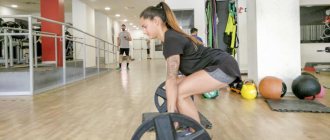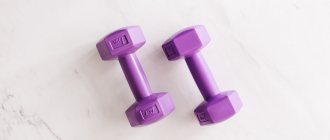The way we look depends on many factors: time of day, state of health, nutrition, posture, etc. And the stomach is no exception.
In this article we look at why your belly can look different, even if a balanced diet and physical activity are constantly present in your life.
After Olya Marquez's stories about how different the belly can look, we received an interesting question: is there any justification for the fact that the belly behaves this way? It turned out there were enough justifications.
Problem: poor posture
Posture is the habitual posture of a casually standing person, in which he is able to hold his body and head upright.
When talking about correct posture, they imagine a vertical line running from the earlobe down along the following points: cervical vertebrae, shoulder angle, mid-thigh, directly behind the knee joint, mid-ankle.
When posture is abnormal, the curves of the spine increase and then hyperlordosis or hyperkyphosis occurs in one or another department, and the position of the body relative to this imaginary line changes.
The task of our musculoskeletal system is to ensure the vertical position of the body and its movement in space. If the curves of the spine change, the muscles adapt to keep the body upright. Muscle balance changes. On one side of the body, the muscles become stronger, and on the other, they relax and lose tone.
If the deflection in the lower back is increased, it means that the back muscles are shortened, and the abdominal muscles, on the contrary, are relaxed, and the stomach begins to move forward, even if there is no excess weight.
What to do
To return the body to the correct position and eliminate muscle imbalance, you need to improve your posture. As soon as the abdominal muscles reach the correct tone, the stomach will look more aesthetically pleasing.
Exercise
A simple option for working with posture from a sitting position is alignment. Sit with your feet flat on the floor and your hip and knee joints at 90 degree angles. Stretch the crown of your head upward, as if you need to grow five centimeters. Lower your shoulders and shoulder blades and hold this position for as long as possible.
If possible, repeat 3-4 times a day and try to hold this position for as long as possible, maintaining calm breathing.
Olga Buzova
Did you think Olya had a flat stomach? But no! This is proven by photographs that were taken at a time when the singing presenter did not know that the lens was aimed at her. On Instagram, of course, you won’t see this, Buzova has complete order there, even if you roll the dough, everything is flat and elastic.
Olya, as a sophisticated celebrity, knows the right angles for herself. So she inhaled and tensed her abs, her stomach fell, the line of her ribs was outlined - the ideal figure is ready! The paparazzi did not stand on ceremony and photographed Buzova at the most inopportune moment. For which we thank them: live photos are further proof that there is no need to develop complexes, we are all human.
And here you can see what the models of the last century look like now: Wrinkles, bellies, fatigue: how famous models from the 90s have changed in 30 years.
Problem: decreased deep muscle tone
Deep muscles—the transverse abdominis and the pelvic diaphragm—hold the abdominal organs in place. Weakening of the deep ones leads to displacement of organs and changes in the contours of the body.
Deep muscles lose tone due to disruption of the breathing cycle. Normally, the thoracoabdominal diaphragm, transverse abdominis muscle and pelvic floor work in concert:
- As you inhale, the diaphragm lowers and moves the abdominal organs slightly downward to make room for inhalation in the chest. The transverse abdominis muscle and pelvic diaphragm relax so that the organs have room to move.
- As you exhale: the pelvic floor muscles and the transverse abdominal muscle tighten, the diaphragm relaxes and returns to its normal position.
The breathing pattern is disrupted if the muscles move in the opposite direction: as you inhale, the stomach tenses and tightens, and as you exhale, it relaxes. Or if the stomach does not move at all during inhalation and exhalation and is constantly retracted.
In both cases, the diaphragm still lowers when inhaling, displacing the internal organs. This increases pressure on the deep muscles from the inside. Because of this, they lose tone over time, and the stomach protrudes forward.
Abdominal exercises won't help
You won’t be able to cope with a stomach that protrudes forward using abdominal exercises, because the deep muscles do not turn on when you exhale at the moment of tension. Working with them is difficult, since we cannot strain them as easily as we strain, for example, the biceps or gluteal muscles.
Moreover, abdominal exercises will only aggravate the situation by increasing intra-abdominal pressure. You can change the situation only by changing your breathing pattern.
It is important to learn to breathe correctly and combine breathing with movement. This will make your workouts better due to better control of body position and supply of oxygen to muscles, and at the same time will prevent loss of tone.
What to do
Do breathing exercises and monitor how you breathe throughout the day. Try to relax your stomach as you inhale and tighten it a little as you exhale.
Breathing exercises can be performed separately from everything else, or can be included in any workout as a separate block. Try doing a video workout and choose to perform regularly those exercises where you best feel the work of the deep muscles.
Track the sensations during training, try to remember them and repeat them under normal loads: for example, when walking, climbing stairs or lifting a child in your arms.
It will be difficult at first, but if you practice this regularly, the body will quickly remember the new breathing pattern for it and soon you will be able to engage the deep muscles, even without particularly concentrating on them.
Important nuances
Target
Before you take care of yourself, it is important to understand why you are doing this. If the goal is clear, it is much easier to move towards it. Some people dream of fitting into their favorite dress and jeans, while others want to find a firm, beautiful body for summer. Everyone has their own goal, they need to strive and try for it.
Reward or motivation
In order for training and efforts to bring positive emotions, it is important not to push yourself into limits, but to motivate yourself with small rewards. For example, at the end of the week, for a good job, you can afford your favorite cake or go to an interesting movie. Having chosen a reward, it is much easier to motivate yourself and strive to achieve what you want.
There must be moderation in everything
Trying to get your body in order, you shouldn’t exhaust yourself with hunger, strict diets, or long-term workouts. Otherwise, instead of the desired effect, you can get serious disruptions in the body. It is important to increase the load gradually.
Problem: bloating
Bloating is a feeling of fullness and “bloating” in the abdomen.
The most common causes are gas accumulation or overeating in a short time. This can happen due to an individual reaction to certain foods, unusual food combinations, overeating, and sometimes stress or fatigue.
What to do
Try to eat regularly in moderate portions, get enough exercise and get quality sleep. Some people find it helpful to eat slowly, as this allows them to better control their portion size and avoid swallowing air along with their food.
Using an elimination diet or keeping a food diary, you can find out which foods or combinations cause an unwanted reaction and minimize them.
Foods that often cause increased gas formation and bloating: cabbage, broccoli, grapes, pears, plums, legumes. The reaction to some of them may go away if you start using them more often.
If bloating has already happened, most often it is enough to just wait and move a little: walk or do some exercise. Moderate gas formation is normal for the gastrointestinal tract and a sign that the bacteria in the intestines are doing their job.
If severe bloating occurs frequently and is accompanied by pain or any other symptoms, this may be a sign of certain gastrointestinal diseases and a reason to consult a doctor.
Treatment
Pre-hospital assistance
Independent elimination of abdominal enlargement is possible with constipation and flatulence. In the first case, laxatives are indicated, in the second - carminatives, limiting products that promote gas formation. The frequent occurrence of these conditions is a reason to consult a gastroenterologist. Other cases of abdominal enlargement, with the exception of nutritional obesity, require urgent diagnosis and treatment by a specialist. In case of sudden development of ascites or intestinal obstruction, it is necessary to call an ambulance.
Conservative therapy
Patients with diseases of the digestive tract are prescribed a special diet. The drug therapy regimen is determined by the nature of the pathology:
- Liver diseases
. Hepatoprotectors, enteroseptics, and agents for normalizing intestinal microflora are used. - Conditions with portal hypertension
. ACE inhibitors, beta-blockers, nitrates, glycosaminoglycans are recommended. - Pathologies of the stomach and intestines
. The list of medications includes enzymes, drugs for restoring microflora, motility regulators, adsorbents, and laxatives. - Gynecological diseases
. For many diseases, including cysts, hormonal drugs are effective. Patients are also prescribed vitamin therapy. - Cardiovascular diseases
. They use antihypertensives, nitrates, diuretics, antiarrhythmics, beta-blockers, antiplatelet agents, and cholesterol-lowering drugs. - Endocrine disorders
. Hormone therapy is indicated. - Oncological diseases
. In some cases, medications from the group of cytostatics are required.
For some non-tumor pathologies, drug therapy is supplemented with physiotherapeutic procedures: acupuncture, balneotherapy, electrical stimulation. In case of tumor processes, along with chemotherapy, radiation therapy may be prescribed.
Surgery
For ascites of any origin that is resistant to conservative therapy, laparocentesis is performed. During one procedure, no more than 5-6 liters of fluid are removed from the abdominal cavity. Massive ascites is an indication for placement of a peritoneal catheter. To eliminate the causes of abdominal enlargement and combat complications that arise, the following interventions are performed:
- Liver diseases
: operations for liver cysts, various resection options, tumor enucleation, drainage and elimination of bile duct strictures. - Portal hypertension
: endoscopic ligation, sclerosis of dilated veins of the esophagus, portocaval, mesentericocaval and selective splenorenal shunting, embolization of the splenic arteries. - Intestinal diseases
: elimination of intestinal obstruction, dissection of adhesions, intestinal resection, hemicolectomy, total colectomy, removal of diverticula. - Extraorgan tumors of the abdomen
: excision of the mesentery, omentectomy, peritonectomy, removal of extraorgan formations. - Gynecological pathologies
: removal of paraovarian cyst or ovarian cystoma, removal of ovarian cyst, ovarian resection, oophorectomy or adnexectomy, uterine amputation, hysterectomy or panhysterectomy. - Endocrine diseases
: removal of an adrenal tumor.
Problem: excess fat tissue
As you gain weight, fat tissue forms throughout your body, but some people are more likely to accumulate it in the abdominal area.
Typically, weight gain is the result of consuming more calories than we expend, and we cannot choose how our body fat is distributed - it is largely determined genetically.
However, according to research, there are factors that are more conducive to the accumulation of abdominal fat and which can be influenced:
- alcohol consumption (especially in men),
- low level of physical activity,
- constantly high level of stress,
- regular lack of sleep,
- smoking.
What to do
Nothing new: healthy eating, regular physical activity, quitting alcohol and smoking, quality sleep and reducing stress levels.
There are no specific exercises that can help you lose weight locally in the abdominal area, but you need to maintain sufficient activity throughout the day and plan regular workouts.
If you are at normal weight but have significant belly fat, physical activity may be even more important than nutrition.
Diet for quick results
If summer has taken you by surprise and you need to quickly get your stomach in order, you can turn to an express diet that will allow you to achieve results in just 5 days. But it is important to resort to such a strict diet in exceptional cases.
For breakfast:
- Regardless of the day, you can indulge in a glass of low-fat yogurt and one orange.
- A glass of low-fat cottage cheese with an apple is also suitable.
- On another day, you can indulge in oatmeal with dried apricots or other dried fruits.
- As an option, a hard-boiled chicken egg with bread. On the last day of the diet, you can eat a slice (40 g) of hard cheese and bread.
For a snack:
- A couple of apples, an orange or banana, 150 g of fresh berries, one bell pepper.
Lunch and dinner (choose one of the items):
- Seasonal vegetable puree soup and egg.
- Boiled slice of lean fish (about 200 g), baked vegetables.
- Vegetable soup with a portion of cheese (cheese no more than 50 g).
- Baked chicken breast (200 g) and vegetable salad, which can be dressed with lemon juice or olive oil.
- Boiled lean meat 100 g and the same amount of beans.
- A couple of potatoes baked in the oven with vegetable salad.
- Seafood - about 200 g.
- Boiled lean chicken with cucumber and two tomatoes.
- Cucumber, hard-boiled chicken egg and beans 200 g.
We should not forget about the drinking regime.
Problem: swelling and fluid retention
Normally, fluid retention in organs and tissues is one of the natural mechanisms for regulating water and electrolyte balance in the body. In a healthy person, swelling and edema can periodically occur and disappear without a trace.
Most women are familiar with fluid retention, especially in the abdominal area, during the premenstrual period and at the beginning of menstruation, and sometimes during ovulation.
According to the American College of Obstetricians and Gynecologists, up to 85% of women experience PMS symptoms, with puffiness being one of the most common. This occurs due to changes in the levels of hormones that control the menstrual cycle, and diet and other lifestyle factors can influence the severity of symptoms.
Other possible causes of edema in a healthy person include: lack of fluids, excess salt and processed foods in the diet, stress, a sedentary lifestyle, alcohol consumption and lack of sleep. We wrote about this in our article “What causes edema and how to deal with it.”
What to do
- Avoid processed and highly salted foods, control salt intake throughout the day: WHO recommends that people limit their salt intake to 5 g per day (teaspoon).
- Eat foods rich in potassium: dark green leafy vegetables - for example, spinach, sweet potatoes, bananas, avocados, tomatoes.
- Drink enough fluids: there is no single norm for water consumption for everyone, focus on your feeling of thirst.
- Minimize sweets and other sources of simple carbohydrates: when digested, they dramatically increase insulin levels in the blood, which causes the kidneys to retain more sodium, which can lead to water retention.
- Exercise regularly: Physical activity helps the lymphatic system function properly and relieves the symptoms of premenstrual syndrome.
If swelling and other symptoms associated with the menstrual cycle are severe and cause you discomfort, contact your obstetrician-gynecologist to rule out pathological causes and prescribe treatment if necessary.
Psychologists' opinion
Psychologists assure that the main factor when choosing a partner should be his personal qualities. Of course, appearance is important, but it plays a leading role only at first. Next, character, ability to communicate, sense of humor and other qualities come to the fore. Therefore, if a man is put off by a small belly, most likely he is not yet planning to enter into a permanent relationship and is focused on sexual intercourse.
And when a person is assessed as a potential sexual partner, appearance plays a huge role. And if the gentleman claims that he is not satisfied with your figure, most likely, you should not count on a long romance and a strong family with him yet.
In what cases should you consult a doctor?
A bulging belly is rarely the result of any serious medical condition, but there are a few things to watch out for.
See your doctor if your belly gets bigger or if you have other symptoms, such as fever, nausea, pain.
A “non-going away” bulging belly with a normal weight can be a symptom of certain diseases of the genitourinary and endocrine systems, gastrointestinal tract, and food intolerance. Get regular preventative checkups and see a doctor if anything worries you.
The imposition of certain standards of beauty has led to a distortion in perception: we began to perceive something normal as ugly. The abdomen can look different, and it is important to distinguish what is normal from what is not normal.
Norm
- folds on the stomach when you sit with your back bent;
- the stomach looks wider when you sit than when you stand;
- the stomach increases during menstruation and after eating;
- there is a small amount of fat on the stomach;
- The stomach expands slightly when you inhale and tightens when you exhale.
Not the norm
- a constantly bloated belly (what is called a “beer belly”);
- cubes on the stomach in women;
- During training, the stomach swells from tension;
- The stomach is constantly retracted and does not participate in breathing.
Normally, the stomach can move and look different not only at different periods of life, but even within one day. The main thing is to understand what is normal for your body and what is not and requires correction.
Authors: Daria Knyazeva, group program instructor, postpartum recovery specialist, trainer-methodologist at the School of the Ideal Body #Sekta; Anna Nesterova, head of scientific information and training at the School of the Ideal Body #sekta
Literature
1. Abdominal fat and what to do about it - Harvard Health. (n.d.). Retrieved October 7, 2022 2. Belly bulge: Causes and treatments. (n.d.). Retrieved October 7, 2022 3. Belly fat in women: Taking - and keeping - it off - Mayo Clinic. (n.d.). Retrieved October 7, 2022 4. Distended Stomach (Abdominal Distention): Symptoms, Signs, Causes & Treatment. (n.d.). Retrieved October 7, 2022 5. Paving the Way for a Healthy Pelvic Floor - IDEA Health & Fitness Association. (n.d.). Retrieved October 7, 2022 6. Period bloating: Causes and remedies. (n.d.). Retrieved October 7, 2021 7. Rossetti, S. R. (2016). Functional anatomy of the pelvic floor. Archivio Italiano Di Urologia e Andrologia, 88(1), 28–37. 8. S, T., & C, D. (2014). Pelvic floor muscle function in women with pelvic floor dysfunction: a retrospective chart review, 1992-2008. International Urogynecology Journal, 25(5), 663–669. 9. Swollen Abdomen: Causes and Treatment. (n.d.). Retrieved October 7, 2021 10. Tricks of the Trade - IDEA Health & Fitness Association. (n.d.). Retrieved October 7, 2022 11. Water retention: Relieve this premenstrual symptom - Mayo Clinic. (n.d.). Retrieved October 7, 2021 12. What causes belly fat and 7 ways to lose it. (n.d.). Retrieved October 7, 2022 13. Why Good Posture Matters. (n.d.). MedBroadCast. 14. Why posture matters - Harvard Health. (n.d.). Retrieved October 7, 2021










